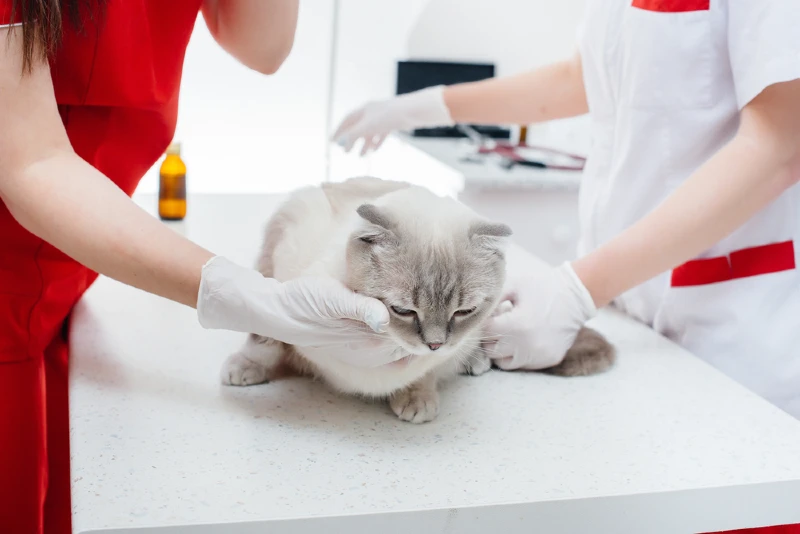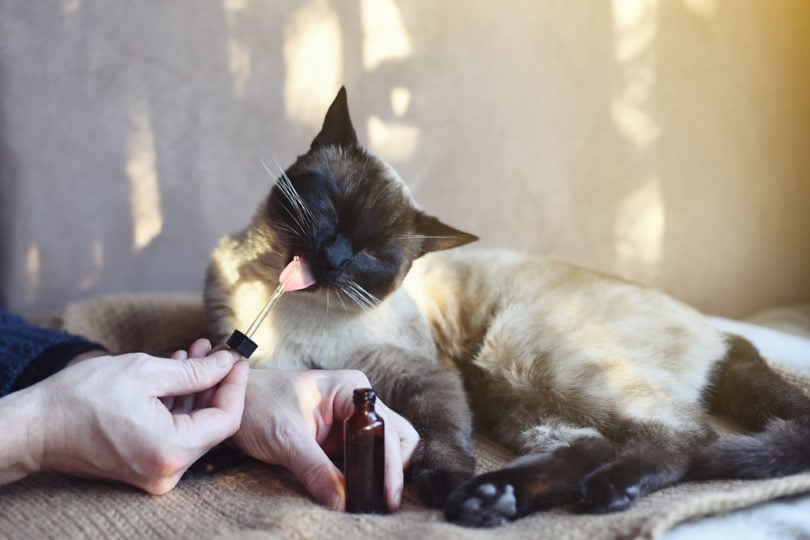Can Cats Eat Cherries? Vet-Reviewed Nutrition Facts & FAQ
Updated on

Many people view their pets as members of their families. It’s no wonder that some may want to share what they’re eating with the dogs or cats. The fact is that animals can’t necessarily eat anything that a human can. Think chocolate, which is highly toxic to canines and felines. As far as cherries are concerned, we must conclude the same thing. It’s best not to give your cat cherries.
Cherries are considered toxic to cats, as the stems, leaves, and seeds contain cyanide, and they should not be given to cats. Consult with your vet if your cat ate cherries. While the meat of the cherry does not contain cyanide, it’s important to speak to your vet before considering offering your cat pitted cherries, as it may not be worth the risk.
The Nutritional Composition of Cherries
At first glance, it may seem like cherries would be okay to give to your pet. After all, they’re over 82% water1. This fruit is also high in potassium and other nutrients. Even though we may argue that cherries are a healthy fruit option for humans, this cannot be extrapolated to felines, as their digestive system and nutritional requirements are very different from ours. Foods that we eat on a daily basis may be quite harmful or even toxic to cats, and before offering your cat any new or human food, it’s important to consult with your veterinarian.
Cherries have a relatively high amount of sugar and carbohydrates at 12.8 and 16 g, respectively. Cats don’t have much of a sweet tooth, so even if there wouldn’t be the risk of cyanide exposure and toxicity from the stems and pits or a risk of choking, they would not make a good treat. Remember that felines are obligate carnivores. You may even call them hypercarnivores since meat makes up over 70% of their daily diet in the wild2. Other than dietary preferences, there’s a few more compelling reasons not to give your pet cherries.
Unfortunately, sugar and some vital nutrients aren’t all this fruit contains.

The Problem With Cherries
This fruit also has compounds called cyanogenic glycosides (CNGs). However, many other plants have them, too, including apricots, apples, and plums. The CNGs are concentrated mainly in the pips or seeds and other parts of the plant, like the leaves and stems. If your cat accidentally swallows a cherry with a seed or the seed itself without biting into it, it may not be an issue when it comes to cyanide, but it may cause a bowel obstruction. Of course, that is a big deal. Seeds may also lead to choking by getting stuck at the back of the throat or blocking an airway.
The other concern is if your cat chews on the cherry pits. That’s when the CNGs come into play. While cherries don’t contain it per se, the chemical reaction with the digestive enzymes will cause the CNGs to convert to hydrogen cyanide or HCN.3 You don’t have to read too many mysteries to know that it’s a problem.
If the ingested amount of cherries was very small, it’s likely to lead to a stomach upset, while the pits may cause a blockage of the stomach and intestines or constipation. In higher quantities or if the amount of CNGs reaches the toxic dose, cats may experience severe respiratory difficulties and shock.
- Vomiting
- Diarrhea
- Abdominal pain
- Shaking and trembling
- Excitability
- Dilated pupils
- Drooling
- Loss of coordination
- Shortness of breath
- Breathing difficulties
- Open mouth breathing
- Brick red gum color
- Convulsions
- Shock
- Loss of consciousness
- Death
The lethal dose of cyanide in most animals is considered to range from 2 to 2.5 mg/kg of body weight., but it can be difficult to estimate how much cyanide is produced within the gastrointestinal tract when CNGs are ingested. Amygdalin is one of the CNGs in cherries.
According to a research paper from the University of Leeds, the amygdalin content of stone fruit seeds could produce cyanide in the range of 0.01 to 1.1 mg cyanide per gram of seed. For very small animals like cats, it may not take too much to cause toxicity.
Luckily, the seeds taste bitter, so your cat isn’t likely to eat them, anyway. However, it’s also worth mentioning that the stems and other parts of the plant also contain CNGs in varying amounts.
Unfortunately, your pet probably won’t know to spit out the seeds. They may play with them and accidentally swallow them, or they may chew on them. While the seeds don’t technically contain hydrogen cyanide, which is the toxic form, there’s enough evidence to steer clear of giving them to your cat. The takeaway message is that the crushed pips are poisonous to your pet. And they are also toxic to you if either of you eats the crushed pips, depending on the amount.

Better Choices for Fruits and Vegetables
There are safe fruit and veggie options for cats, but because your cat is a carnivore, they do not need this as a part of their diet, and it’s unlikely to benefit them. Fruits are rich in carbs, and cats don’t have a dietary requirement for carbohydrates, not to mention that cats’ digestion is not suited for eating sugary food. Excess sugar and calories over time may lead to weight gain, and cats suffering with diabetes, in particular, should not be having sugary treats.
A cat’s diet is based on a high amount of animal protein with moderate amounts of fat. This doesn’t mean you can’t offer your pet an occasional and very small amount of safe fruits and vegetables, but definitely do not make a habit of it.
- Strawberries
- Blueberries
- Pumpkin
- Bananas
Just make sure to cut them into small pieces to make it easier for your pet to swallow. We also recommend limiting fruits and vegetables to just a few times a week and not to make it a daily occurence. Your kitty’s food should be their primary source of nutrients.
Final Thoughts
The essential thing to remember is that it isn’t a given that anything you can eat you can also give to your pet. Always check with your vet before you offer your cat anything new. Cherry meat as a fruit isn’t necessarily bad. It’s the other parts of the plant that are problematic, and it’s just not worth the risk for your kitty. We suggest playing it safe with other foods your pet can enjoy.
Related Reads:
Featured Image Credit: Pixabay














